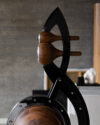Technical
Perfect Sound From All Directions

Narrow and broadband smoothness of the on-axis and off-axis early room reflections ensures a naturally balanced sound power, shown in blinded tests to be essential for perceived loudspeaker sound quality.
Uniform Power Response
The on-axis sound coming directly from the loudspeaker is heard first. The off-axis sound reflected by walls, floor and ceiling of the listening room reaches the listener’s ears slightly later and less intensive than the direct sound. Both must be smooth closely matching each other across the entire audible frequency range.
The chart below shows the near field 1/6 Octave smoothed On-Axis and Off-Axis response of the TCA-M loudspeaker in 15 degree increments out to 90 degrees.
As seen in the graph, off-axis responses only start diverging above about 4KHz with an extremely smooth roll-off out to 24KHz.

Psychoacoustic Attention to Artefacts
Perceiving layers and position of sound events on an imaginary three-dimensional canvas depends on the loudspeakers disappearing from the subconscious mind’s attention and is essential to listener preference.
Spurious sound artefacts generated by a loudspeaker cannot be unheard and collapses the phantom image. Two main sources of sound artefacts are diffraction and lobing, which respectively causes extra chaotic sound waves and patterns of missing sound.


Diffraction
In conventional loudspeaker designs, each speaker driver is front firing mounted on a flat baffle. The baffle is easily smaller than the bass wavelengths and present no diffraction issues. However, in the mid-range and high frequencies the baffle will cause diffraction.
For example, at 20KHz the wavelength is about 17mm. Many tweeter drivers have an overall diameter of 60mm or more, which will limit the diffraction free frequency range to below about 6Khz made worse by the addition of a sizeable baffle with edges. The illustration above shows how the primary wavefront from the speaker driver is met by secondary wavefronts reflected off the baffle and edges causing diffraction interference patterns.
A point source smaller than the shortest wavelength would be ideal. Unfortunately the laws of physics and practical considerations such as required sound pressure level, makes such an ideal point source impossible to engineer.
A practical solution must allow sound waves to flow smoothly and uniformly all around a loudspeaker avoiding any flat surfaces and edges diffracting the sound.


Our active loudspeakers are intentionally sculpted and slender for smooth uniform sound power.
Lobing
Lobing occurs because the sound energy of the audible frequency range must be divided between two or more speaker drivers able to precisely move a certain volume of air: a woofer for the bass, a mid-range driver and tweeter for the higher frequencies. The acoustic center of the drivers as a result are not on the same axis and have a minimal distance between them that depends on their size.
To divide the audio signal between the drivers, an electronic circuit called a crossover is needed. Conventionally, such a crossover is passive resulting in pairs of drivers sharing a substantial overlap of frequencies and is associated with non-linear phase challenges.
Oversimplified, lobing can be expressed in terms of wavelength and the distance between the acoustic centres of two point sources leading to a vertical radiation pattern of lobes around the crossover frequency, as illustrated above.

The TCA-M loudspeaker sound dispersion behaviour is consistent in both the horizontal and vertical plane, exhibiting negligible lobing and diffraction artefacts.
A single point source covering the entire audible frequency spectrum would be the ideal solution for altogether avoiding diffraction and lobing, but practically impossible to realise. Coaxial drivers incorporating a midrange and tweeter driver on the same axis is a possibility, but brings along other issues such as the tweeter having a moving midrange diaphragm as it’s too large and modulating baffle.
Lobing can and must be limited as it affects timbre, is listening position dependent and draws distracting psychoacoustic attention to the loudspeaker’s location. The acoustic centre of mid-range and treble speaker drives must be physically close and with the crossover design optimally integrating sound to minimise lobing.
The built-in state-of-the-art DSP technology ensures optimal handover between bass, mid-range and treble through minimal sharing of frequencies from one driver to the next, while achieving both linear frequency and phase behaviour.
An optimal sonic experience is consistently delivered from separate powerful and dynamic low distortion amplifiers dedicated to each frequency range and connected by short internal cabling to the speaker units for unmatched control of their movement.
To learn more please download our “Room Acoustics, Psychoacoustics and TCA-M Design Concepts” white paper and the Features and Technical Specification.


